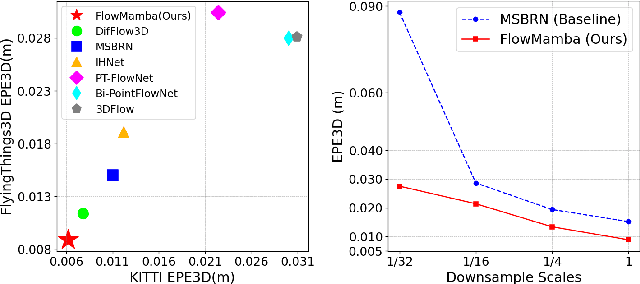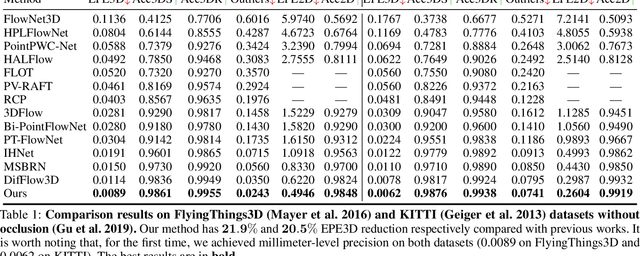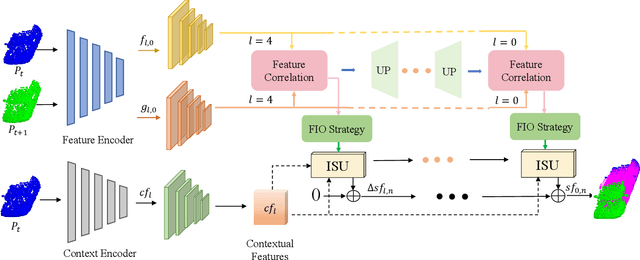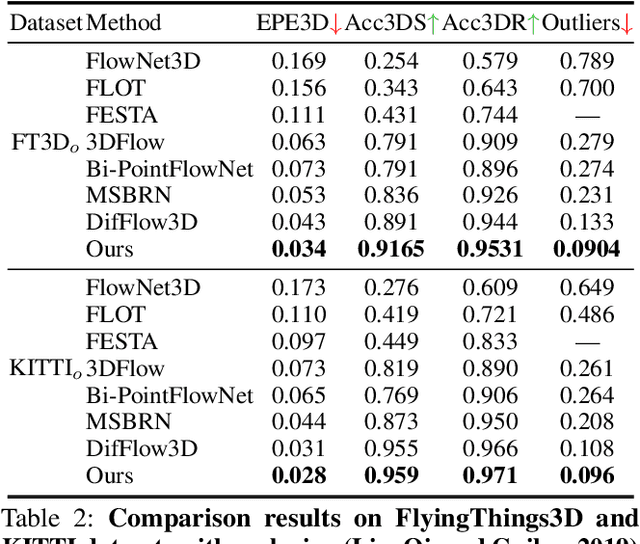Xianqi Wang
Pixel-Perfect Depth with Semantics-Prompted Diffusion Transformers
Oct 08, 2025Abstract:This paper presents Pixel-Perfect Depth, a monocular depth estimation model based on pixel-space diffusion generation that produces high-quality, flying-pixel-free point clouds from estimated depth maps. Current generative depth estimation models fine-tune Stable Diffusion and achieve impressive performance. However, they require a VAE to compress depth maps into latent space, which inevitably introduces \textit{flying pixels} at edges and details. Our model addresses this challenge by directly performing diffusion generation in the pixel space, avoiding VAE-induced artifacts. To overcome the high complexity associated with pixel-space generation, we introduce two novel designs: 1) Semantics-Prompted Diffusion Transformers (SP-DiT), which incorporate semantic representations from vision foundation models into DiT to prompt the diffusion process, thereby preserving global semantic consistency while enhancing fine-grained visual details; and 2) Cascade DiT Design that progressively increases the number of tokens to further enhance efficiency and accuracy. Our model achieves the best performance among all published generative models across five benchmarks, and significantly outperforms all other models in edge-aware point cloud evaluation.
DEPTHOR++: Robust Depth Enhancement from a Real-World Lightweight dToF and RGB Guidance
Sep 30, 2025Abstract:Depth enhancement, which converts raw dToF signals into dense depth maps using RGB guidance, is crucial for improving depth perception in high-precision tasks such as 3D reconstruction and SLAM. However, existing methods often assume ideal dToF inputs and perfect dToF-RGB alignment, overlooking calibration errors and anomalies, thus limiting real-world applicability. This work systematically analyzes the noise characteristics of real-world lightweight dToF sensors and proposes a practical and novel depth completion framework, DEPTHOR++, which enhances robustness to noisy dToF inputs from three key aspects. First, we introduce a simulation method based on synthetic datasets to generate realistic training samples for robust model training. Second, we propose a learnable-parameter-free anomaly detection mechanism to identify and remove erroneous dToF measurements, preventing misleading propagation during completion. Third, we design a depth completion network tailored to noisy dToF inputs, which integrates RGB images and pre-trained monocular depth estimation priors to improve depth recovery in challenging regions. On the ZJU-L5 dataset and real-world samples, our training strategy significantly boosts existing depth completion models, with our model achieving state-of-the-art performance, improving RMSE and Rel by 22% and 11% on average. On the Mirror3D-NYU dataset, by incorporating the anomaly detection method, our model improves upon the previous SOTA by 37% in mirror regions. On the Hammer dataset, using simulated low-cost dToF data from RealSense L515, our method surpasses the L515 measurements with an average gain of 22%, demonstrating its potential to enable low-cost sensors to outperform higher-end devices. Qualitative results across diverse real-world datasets further validate the effectiveness and generalizability of our approach.
DEPTHOR: Depth Enhancement from a Practical Light-Weight dToF Sensor and RGB Image
Apr 02, 2025Abstract:Depth enhancement, which uses RGB images as guidance to convert raw signals from dToF into high-precision, dense depth maps, is a critical task in computer vision. Although existing super-resolution-based methods show promising results on public datasets, they often rely on idealized assumptions like accurate region correspondences and reliable dToF inputs, overlooking calibration errors that cause misalignment and anomaly signals inherent to dToF imaging, limiting real-world applicability. To address these challenges, we propose a novel completion-based method, named DEPTHOR, featuring advances in both the training strategy and model architecture. First, we propose a method to simulate real-world dToF data from the accurate ground truth in synthetic datasets to enable noise-robust training. Second, we design a novel network that incorporates monocular depth estimation (MDE), leveraging global depth relationships and contextual information to improve prediction in challenging regions. On the ZJU-L5 dataset, our training strategy significantly enhances depth completion models, achieving results comparable to depth super-resolution methods, while our model achieves state-of-the-art results, improving Rel and RMSE by 27% and 18%, respectively. On a more challenging set of dToF samples we collected, our method outperforms SOTA methods on preliminary stereo-based GT, improving Rel and RMSE by 23% and 22%, respectively. Our Code is available at https://github.com/ShadowBbBb/Depthor
BANet: Bilateral Aggregation Network for Mobile Stereo Matching
Mar 05, 2025Abstract:State-of-the-art stereo matching methods typically use costly 3D convolutions to aggregate a full cost volume, but their computational demands make mobile deployment challenging. Directly applying 2D convolutions for cost aggregation often results in edge blurring, detail loss, and mismatches in textureless regions. Some complex operations, like deformable convolutions and iterative warping, can partially alleviate this issue; however, they are not mobile-friendly, limiting their deployment on mobile devices. In this paper, we present a novel bilateral aggregation network (BANet) for mobile stereo matching that produces high-quality results with sharp edges and fine details using only 2D convolutions. Specifically, we first separate the full cost volume into detailed and smooth volumes using a spatial attention map, then perform detailed and smooth aggregations accordingly, ultimately fusing both to obtain the final disparity map. Additionally, to accurately identify high-frequency detailed regions and low-frequency smooth/textureless regions, we propose a new scale-aware spatial attention module. Experimental results demonstrate that our BANet-2D significantly outperforms other mobile-friendly methods, achieving 35.3\% higher accuracy on the KITTI 2015 leaderboard than MobileStereoNet-2D, with faster runtime on mobile devices. The extended 3D version, BANet-3D, achieves the highest accuracy among all real-time methods on high-end GPUs. Code: \textcolor{magenta}{https://github.com/gangweiX/BANet}.
SVDC: Consistent Direct Time-of-Flight Video Depth Completion with Frequency Selective Fusion
Mar 03, 2025Abstract:Lightweight direct Time-of-Flight (dToF) sensors are ideal for 3D sensing on mobile devices. However, due to the manufacturing constraints of compact devices and the inherent physical principles of imaging, dToF depth maps are sparse and noisy. In this paper, we propose a novel video depth completion method, called SVDC, by fusing the sparse dToF data with the corresponding RGB guidance. Our method employs a multi-frame fusion scheme to mitigate the spatial ambiguity resulting from the sparse dToF imaging. Misalignment between consecutive frames during multi-frame fusion could cause blending between object edges and the background, which results in a loss of detail. To address this, we introduce an adaptive frequency selective fusion (AFSF) module, which automatically selects convolution kernel sizes to fuse multi-frame features. Our AFSF utilizes a channel-spatial enhancement attention (CSEA) module to enhance features and generates an attention map as fusion weights. The AFSF ensures edge detail recovery while suppressing high-frequency noise in smooth regions. To further enhance temporal consistency, We propose a cross-window consistency loss to ensure consistent predictions across different windows, effectively reducing flickering. Our proposed SVDC achieves optimal accuracy and consistency on the TartanAir and Dynamic Replica datasets. Code is available at https://github.com/Lan1eve/SVDC.
MonSter: Marry Monodepth to Stereo Unleashes Power
Jan 15, 2025Abstract:Stereo matching recovers depth from image correspondences. Existing methods struggle to handle ill-posed regions with limited matching cues, such as occlusions and textureless areas. To address this, we propose MonSter, a novel method that leverages the complementary strengths of monocular depth estimation and stereo matching. MonSter integrates monocular depth and stereo matching into a dual-branch architecture to iteratively improve each other. Confidence-based guidance adaptively selects reliable stereo cues for monodepth scale-shift recovery. The refined monodepth is in turn guides stereo effectively at ill-posed regions. Such iterative mutual enhancement enables MonSter to evolve monodepth priors from coarse object-level structures to pixel-level geometry, fully unlocking the potential of stereo matching. As shown in Fig.1, MonSter ranks 1st across five most commonly used leaderboards -- SceneFlow, KITTI 2012, KITTI 2015, Middlebury, and ETH3D. Achieving up to 49.5% improvements (Bad 1.0 on ETH3D) over the previous best method. Comprehensive analysis verifies the effectiveness of MonSter in ill-posed regions. In terms of zero-shot generalization, MonSter significantly and consistently outperforms state-of-the-art across the board. The code is publicly available at: https://github.com/Junda24/MonSter.
StereoGen: High-quality Stereo Image Generation from a Single Image
Jan 15, 2025Abstract:State-of-the-art supervised stereo matching methods have achieved amazing results on various benchmarks. However, these data-driven methods suffer from generalization to real-world scenarios due to the lack of real-world annotated data. In this paper, we propose StereoGen, a novel pipeline for high-quality stereo image generation. This pipeline utilizes arbitrary single images as left images and pseudo disparities generated by a monocular depth estimation model to synthesize high-quality corresponding right images. Unlike previous methods that fill the occluded area in warped right images using random backgrounds or using convolutions to take nearby pixels selectively, we fine-tune a diffusion inpainting model to recover the background. Images generated by our model possess better details and undamaged semantic structures. Besides, we propose Training-free Confidence Generation and Adaptive Disparity Selection. The former suppresses the negative effect of harmful pseudo ground truth during stereo training, while the latter helps generate a wider disparity distribution and better synthetic images. Experiments show that models trained under our pipeline achieve state-of-the-art zero-shot generalization results among all published methods. The code will be available upon publication of the paper.
FlowMamba: Learning Point Cloud Scene Flow with Global Motion Propagation
Dec 23, 2024



Abstract:Scene flow methods based on deep learning have achieved impressive performance. However, current top-performing methods still struggle with ill-posed regions, such as extensive flat regions or occlusions, due to insufficient local evidence. In this paper, we propose a novel global-aware scene flow estimation network with global motion propagation, named FlowMamba. The core idea of FlowMamba is a novel Iterative Unit based on the State Space Model (ISU), which first propagates global motion patterns and then adaptively integrates the global motion information with previously hidden states. As the irregular nature of point clouds limits the performance of ISU in global motion propagation, we propose a feature-induced ordering strategy (FIO). The FIO leverages semantic-related and motion-related features to order points into a sequence characterized by spatial continuity. Extensive experiments demonstrate the effectiveness of FlowMamba, with 21.9\% and 20.5\% EPE3D reduction from the best published results on FlyingThings3D and KITTI datasets. Specifically, our FlowMamba is the first method to achieve millimeter-level prediction accuracy in FlyingThings3D and KITTI. Furthermore, the proposed ISU can be seamlessly embedded into existing iterative networks as a plug-and-play module, improving their estimation accuracy significantly.
IGEV++: Iterative Multi-range Geometry Encoding Volumes for Stereo Matching
Sep 01, 2024Abstract:Stereo matching is a core component in many computer vision and robotics systems. Despite significant advances over the last decade, handling matching ambiguities in ill-posed regions and large disparities remains an open challenge. In this paper, we propose a new deep network architecture, called IGEV++, for stereo matching. The proposed IGEV++ builds Multi-range Geometry Encoding Volumes (MGEV) that encode coarse-grained geometry information for ill-posed regions and large disparities and fine-grained geometry information for details and small disparities. To construct MGEV, we introduce an adaptive patch matching module that efficiently and effectively computes matching costs for large disparity ranges and/or ill-posed regions. We further propose a selective geometry feature fusion module to adaptively fuse multi-range and multi-granularity geometry features in MGEV. We then index the fused geometry features and input them to ConvGRUs to iteratively update the disparity map. MGEV allows to efficiently handle large disparities and ill-posed regions, such as occlusions and textureless regions, and enjoys rapid convergence during iterations. Our IGEV++ achieves the best performance on the Scene Flow test set across all disparity ranges, up to 768px. Our IGEV++ also achieves state-of-the-art accuracy on the Middlebury, ETH3D, KITTI 2012, and 2015 benchmarks. Specifically, IGEV++ achieves a 3.23% 2-pixel outlier rate (Bad 2.0) on the large disparity benchmark, Middlebury, representing error reductions of 31.9% and 54.8% compared to RAFT-Stereo and GMStereo, respectively. We also present a real-time version of IGEV++ that achieves the best performance among all published real-time methods on the KITTI benchmarks. The code is publicly available at https://github.com/gangweiX/IGEV-plusplus
Histology Virtual Staining with Mask-Guided Adversarial Transfer Learning for Tertiary Lymphoid Structure Detection
Aug 26, 2024Abstract:Histological Tertiary Lymphoid Structures (TLSs) are increasingly recognized for their correlation with the efficacy of immunotherapy in various solid tumors. Traditionally, the identification and characterization of TLSs rely on immunohistochemistry (IHC) staining techniques, utilizing markers such as CD20 for B cells. Despite the specificity of IHC, Hematoxylin-Eosin (H&E) staining offers a more accessible and cost-effective choice. Capitalizing on the prevalence of H&E staining slides, we introduce a novel Mask-Guided Adversarial Transfer Learning method designed for virtual pathological staining. This method adeptly captures the nuanced color variations across diverse tissue types under various staining conditions, such as nucleus, red blood cells, positive reaction regions, without explicit label information, and adeptly synthesizes realistic IHC-like virtual staining patches, even replicating the positive reaction. Further, we propose the Virtual IHC Pathology Analysis Network (VIPA-Net), an integrated framework encompassing a Mask-Guided Transfer Module and an H&E-Based Virtual Staining TLS Detection Module. VIPA-Net synergistically harnesses both H\&E staining slides and the synthesized virtual IHC patches to enhance the detection of TLSs within H&E Whole Slide Images (WSIs). We evaluate the network with a comprehensive dataset comprising 1019 annotated slides from The Cancer Genome Atlas (TCGA). Experimental results compellingly illustrate that the VIPA-Net substantially elevates TLS detection accuracy, effectively circumventing the need for actual CD20 staining across the public dataset.
 Add to Chrome
Add to Chrome Add to Firefox
Add to Firefox Add to Edge
Add to Edge